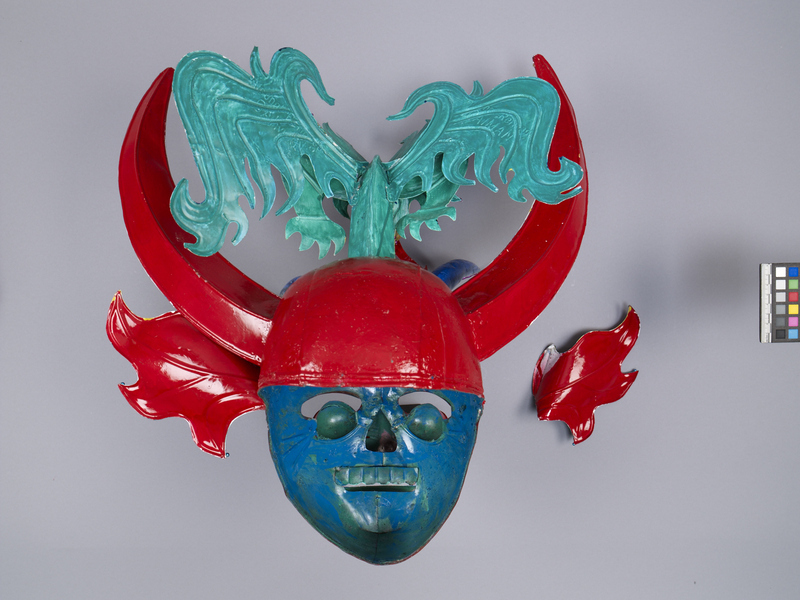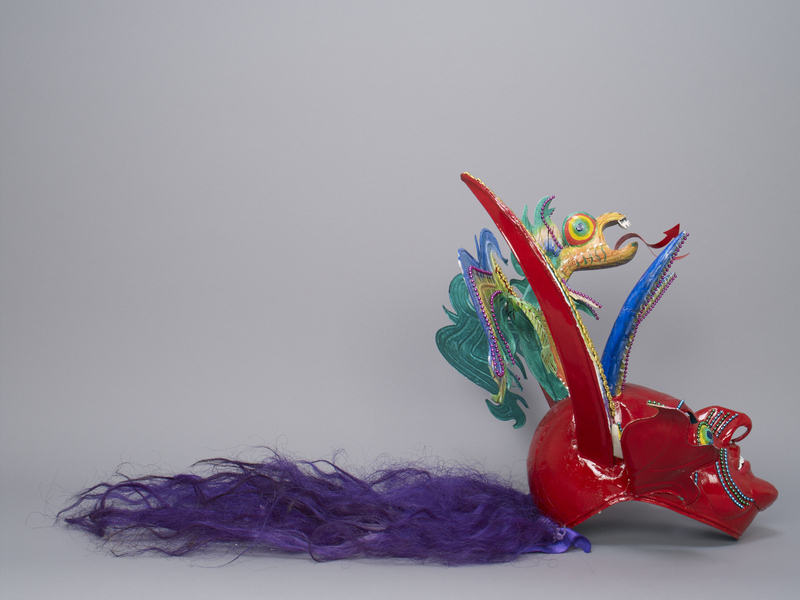Devil Mask Item Number: 2946/7 a-b from the MOA: University of British Columbia



Description
Large devil mask of painted tin. The head is all red with multicoloured eyes, protruding flame-shaped ears, two sets of horns curving in different directions, and a dragon projecting from the top of the head. There are blue and green plastic beads attached in rows on the red face and ears, pink beads attached to the smaller set of horns and the dragon, and gold coloured ornamental strips attached to the larger horns. The ears, horns and the dragon are multicoloured (mainly blue, yellow and green, with some red and pink). There is a separate purple hairpiece (part b) that hangs at the back.
History Of Use
Supay mask; used in the diablada dance performances, during the Virgin of Candelaria feast days. For the people of the Andes, metals were considered "like the harvests, products of the earth", and to extract them, in the colonial period and today, a prospective miner or speculator must be prepared to make a contract with their proprietor. There were various proprietors throughout the centuries, with Supay, also identified as Apo Parato, appearing around 1650. Miners made offerings of chicha, feathers, and diminutive wax effigies for Supay; they hoped for clothes, silver, and food in return. In many of his depictions, Supay has a large erect phallus and can return a miner's lost virility. He has an intimidating and belittling attitude to his supplicants, and the minerals hidden in his cavernous world are often though to be false riches. He is associated with the remaking of the world after the Spanish invasion; also associated with sickness and death.
Narrative
Purchased from the maker in Puno.
Item History
- Made by Oswaldo Ramos Leon (Maker) in Puno, Peru during 2011
- Collected by Anthony A. Shelton during February 2012
- Owned by Anthony A. Shelton before March 12, 2012
- Received from Anthony A. Shelton (Seller) and Museum of Anthropology Exhibitions Budget (Funding source) on March 12, 2012
What
Who
- Culture
- Peruvian
- Creator
- Oswaldo Ramos Leon (Maker)
- Field Collector
- Anthony A. Shelton
- Previous Owner
- Anthony A. Shelton
- Received from
- Anthony A. Shelton (Seller) and Museum of Anthropology Exhibitions Budget (Funding source)
Where
- Holding Institution
- MOA: University of British Columbia
- Made in
- Puno, Peru
When
- Creation Date
- during 2011
- Collection Date
- during February 2012
- Ownership Date
- before March 12, 2012
- Acquisition Date
- on March 12, 2012
Other
- Item Classes
- metalwork
- Condition
- fair
- Accession Number
- 2946/0007 a-b